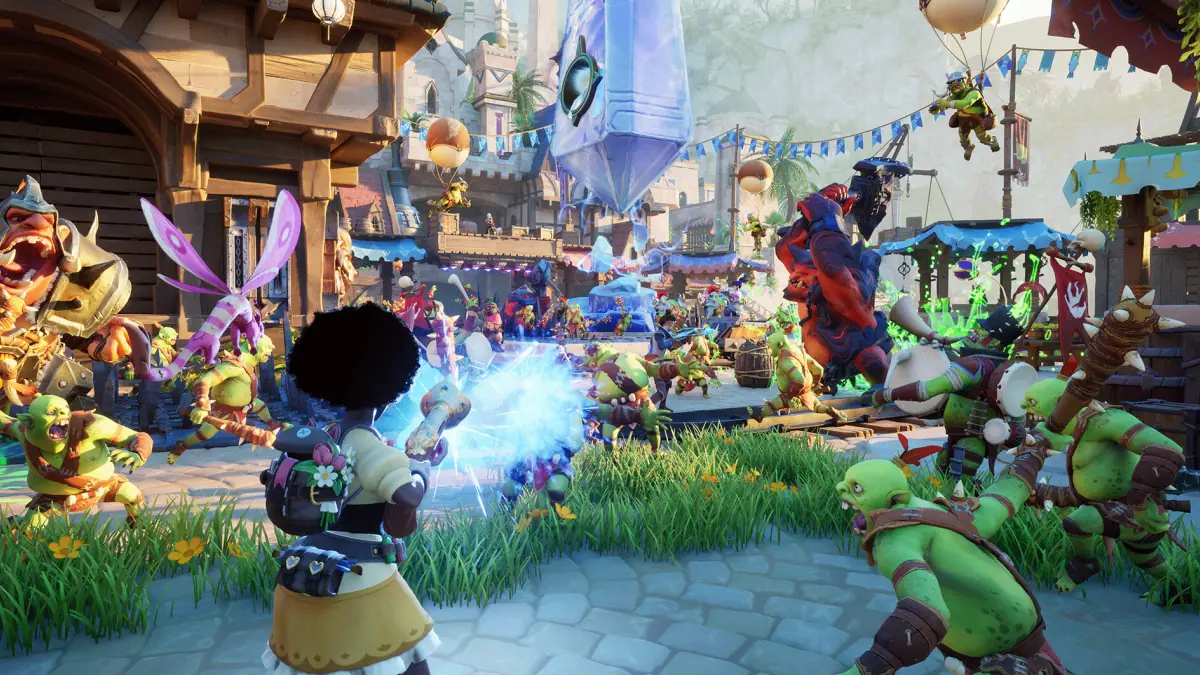Feature: Making Two Worlds 2: An underdog RPG with a magic secret
9 min. read
Published on
Read our disclosure page to find out how can you help MSPoweruser sustain the editorial team Read more

The original Two Worlds has a lot of lasting power for being a game of such lax quality. It’s one of those titles that pops up from time-to-time, frequently in jest, to the point where it’s a remarkably recognisable game despite its infamy. Think Too Human, Mindjack or Devil’s Third—the type of product remembered through a fond smile followed by a snort.
For a game with a box quote stating it was “Oblivion on steroids”, Two Worlds is a pale imitator of Bethesda’s AAA RPG, although its ambition was certainly amiable. Outside of a winsome B-movie feel though, it was essentially broken. There were more bugs than the cracked rock floors of Vvardenfell, considerably worse voice acting than its Elder Scrolls contemporary and combat that felt like you were simply slapping foes with a damp towel.

But inside all of this were some decent ideas hidden within the cracks. Unlike a lot of RPGs at the time, there were no classes to be seen within its systems. You’d pick up gear, skill books and magic cards that would allow you to adapt on the fly; a simple skill tree would help you pick a straight class if you wanted it. While it slipped in a lot of areas, player freedom was a key focus. It became a mantra for Polish developer Reality Pump, one that would be deeply integrated into the game’s wholly underrated sequel.
“We wanted to give you the freedom to create whatever you wanted to make,” developer Tomasz Kozera told me, a statement which rang true for the entirety of Two Worlds 2’s development. The original game and its sequel were huge departures from the games that Reality Pump made before. While Two Worlds was an open-world role-playing game that you could sink hundreds of hours into, most of the developer’s prior work was anchored in the RTS genre.
Moving genres was a huge shift for a studio of their size. Even when starting development on the Two Worlds sequel, Reality Pump had just over twenty employees to create an entire RPG. For a small Polish studio, this was a daunting task that would finish with just over forty people having a hand in its creation. Before the days of The Witcher 3 and the upcoming Cyberpunk 2099, Poland wasn’t the rising star in video games that it is today. Games developed in Poland were often small, delegated to single platforms and low in budget. Even CD Projekt RED’s The Witcher 2, an eight-year-old game, only say release on two of its generation’s platforms. Two Worlds 2 would be released on three.

“We had this weird feeling that nobody in Poland knew that there is this kind of game,” Kozera told me. The team knew that whatever they created would be welcomed in the US and the UK, but at that point in time, Polish gamers were still very much being introduced to new games actually being developed in their countries. “It felt kind of weird, but we knew we were doing something special, on a bigger scale. We were also releasing on multiple platforms, which at that point in time was quite difficult. Not many studios did that in Poland, it was really empowering for us.”
Starting off as an intern in his first games industry position, Kozera eventually ended up having a hand in almost every aspect of design in Two Worlds 2. Teaming up with another programmer, his first project would be to create an engine tool that would randomly generate the game’s caves and dungeons, something that eventually only got used as a baseline for layouts as designers wanted a more hands-on approach. By the end of development, Kozera’s name is attached to everything from scripting and bug fixing to quest design and story design.
At Reality Pump, everyone balanced numerous roles. Programmers would also be quest designers, scripters would also create 3D models. Everyone had three or four responsibilities that they would be in charge of. Reality Pump didn’t even have a dedicated UI artist, that responsibility would be handled by the game’s project lead. This would never leave the collaborative spirit of Reality Pump. Hell, during early development of their next game Sacrilegium, Kozera himself would have a hang in designing the game’s HUD.
It’s hearing information like this that makes Two Worlds 2 sound like a miracle project; developers banding together and sharing responsibility in order to create the product that they desperately wanted to make. A true collaboration between fantastic minds occurs every day within the games industry, but a shared effort on this scale is a rare thing indeed.

No mechanic in the entirety of Two Worlds 2 shows this the team’s collaborative efforts more than the game’s remarkably in-depth magic system, something which still remains the most intuitive and creative aspect of the game. Despite being an enjoyable action-RPG with a campaign, entirely separate co-op multiplayer mode, a village building simulator and more, it’s this feature that’s the epitome of how a small group of developers made a game all about playing how you want to play. Completely unnecessary and unbelievably unique, that’s what Two Worlds 2’s magic system is and what Two Worlds 2 is as a whole.
“The only thing I drew from the first Two Worlds was the idea of magic cards,” Kozera told me. In Two Worlds 2, you don’t learn magic through experience, you make your own spells. Using an Amulet of Spell, you can combine elements with effects to create tornados that home in on enemies or a missile that hits pauses your enemy’s movements and then spawns a demon to attack them. With every item in the game being completely physics based, experimenting with spells can lead to some very interesting combinations.
Magic cards was the team’s way of making the system balanced while not dictating a set path on how you should play. Magic cards could be found in loot drops, purchased at shops or discovered in dungeons; improving your magic skills was up to the rules of your adventure. “Skillbooks and cards were something that you could buy and that created an interesting incentive for players to spend cash on it,” Kozera reminded me. “We had a smart system… to make sure that whatever players pick, it’ll be more or less balanced.”
Of course, development will always see features or bonus additives get cut from games, mostly in order to get them running at playable speeds on console. “One thing that had to be cut down was the magic system. With the system, you can create a large chain of effects, and initially, you could build longer chains that just kept going. We initially had five times the number of objects… you could have thirty or so projectiles flying around but if you went into spamming missiles or some of the monsters then the consoles would actually die.”
If Kozera were to return to Two Worlds 2—much like Reality Pump has been doing with the game’s out-of-nowhere expansion last year—he says he would leave the magic system untouched. “I think, maybe, I’d use it as an optional mod because it did some interesting things. But this decision was done quite early… it could make the mage way too powerful.”
Two Worlds 2 has not been forgotten. In a weird turn of events, it’s a game that continues to live on even to this day. An expansion in 2017 alongside a complete engine upgrade and an upcoming expansion in Q3 2019 has quizzically extended the life of this niche last-gen title way beyond what anyone would have predicted. It doesn’t just surprise you and I, it even surprises some of the original game’s developers.
However, the team behind these expansions are not the same as the underdog team that created the original. Most of those developers moved onto other prospects after Reality Pump abandoned Two Worlds in favour of a never-released horror title called Sacriliegium.

“Some people decided that after the project they wanted to do something else, but some people really wanted to do Two Worlds 3. But it didn’t happen—that made a few people leave,” Tomasz recalls. With CD Projekt RED opening up a studio in Kraków, new job prospects opened and many of Two Worlds 2’s developers went to work on The Witcher 3 and Cyberpunk 2099.
Two Worlds 2 was always an important game to me. I played it as a kid on holiday; I played pretend pirates while the outside was ravaged by a particularly angry thunderstorm. Even in the wealth of Amazon’s “games on sale” section as a 15-year-old kid, Two Worlds 2 was an underdog. However, I can wholeheartedly say it’s one of the greatest underdogs of the last generation and one that’s creation story makes its strengths even more remarkable.








User forum
0 messages